Contents
Eggplant leaves dry in a greenhouse – a problem that every gardener who grows this crop can face. Trouble occur for a number of reasons. To find out for which one, you should pay close attention to compliance with the rules of agricultural technology and the plant itself.
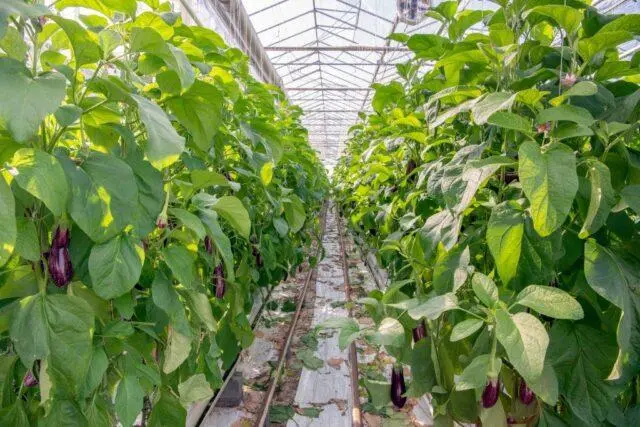
Eggplant is a capricious crop that requires good care, both in the greenhouse and in the open field.
Why do eggplant leaves dry up?
If eggplant leaves dry, the reasons for this may be different circumstances. Any violation of agricultural technology or inconsistency in the conditions in the greenhouse is reflected in the plant. Withering, yellowing, drying of leaf plates is an alarming symptom and requires the prompt elimination of the causes of its occurrence.
Unsuitable soil
For the good development of eggplants, when planting them in a greenhouse, you need to choose the right soil. The plant prefers nutritious and loose soil, which is desirable to prepare since autumn. You can not plant eggplant in dense or heavy, peaty soil, and it is also not recommended to use sandy or too light soil for this. In the case when such a substrate is in the greenhouse, the culture will develop incorrectly, its leaves will begin to dry, turn yellow and fall off.

The soil for planting eggplant should have good aeration.
Incorrect watering
Eggplants are very fond of water, but waterlogging for them, as well as overdrying, is highly undesirable. In the first case, the roots of the plant begin to rot, and in the second – to dry, which first of all affects the state of the aerial part of the bush.
Optimal for eggplant growing in a greenhouse is watering twice a week. When flowers and fruits are tied on the plant, the frequency of moistening is increased up to three times. At the same time, about 5 liters of water are used per plant.
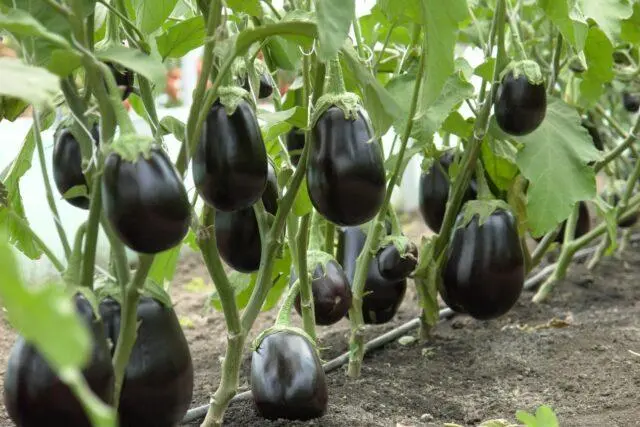
The culture is watered under the root, while it is best to use drip irrigation
Temperature changes
Eggplant is a heat-loving plant that reacts painfully to cold, but at a temperature in the greenhouse of more than +27 ° C, it also feels bad. Due to the intense heat, the leaves of the culture dry, lose their elasticity and fall off. Temperature control helps prevent problems. During the increase in the thermometer in the greenhouse, doors and windows are opened, but everything is closed at night, because if the temperature drops to +15 ° C, the eggplants will get sick and stop forming fruits. The leaves may also turn yellow and dry.
lack of light
In a greenhouse, a plant often suffers from a lack of light, for which gardeners install fitolamps there. As a result, with their unreasonable use, eggplant leaves get burned, the plates begin to dry and curl.
In order for the bushes to receive enough light, they need to be planted correctly. Eggplants are sprawling and powerful, do not tolerate close proximity to each other, they place a maximum of three pieces per square meter. It is also important when growing in a greenhouse to form them into one or two stems so that the extra shoots do not thicken the plantings. Otherwise, the bushes will be deprived of the sun’s rays, and their leaves will also begin to dry.
Lack of nutrients
The appearance of eggplant bushes also changes due to a lack of nutrients. Usually the leaves turn yellow, curl and dry due to a lack of potassium. In addition, they can lighten and fade due to nitrogen deficiency. If the leaf plates turn yellowish and their veins remain dark green, this indicates a lack of magnesium.
Top dressing helps to cope with the problem. They are usually entered in the following way:
- After picking and a week before transplanting into the greenhouse, eggplants are watered with a solution of potassium, phosphorus and nitrogen.
- A couple of weeks after planting, fertilize with the same mixture.
- At the time of flowering and fruit set, potassium and phosphorus.
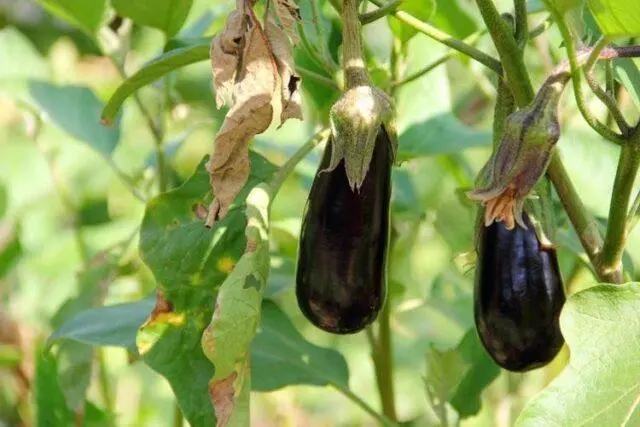
As an eggplant fertilizer, you can use universal formulations for vegetable crops
Transplant stress
So that the plant does not receive stress after transplantation, often when grown in a warm greenhouse, eggplants are immediately sown in a permanent place. And if you have to grow seedlings at home, then it is recommended to harden it correctly. In the case when the bushes do not undergo adaptation, their leaves begin to dry and fall off. This process is natural, and usually after a few weeks a healthy appearance returns to the culture.
Root damage
Often, the delicate root system of eggplants is damaged when they are transplanted into a greenhouse, due to which the foliage can dry and change color. To prevent this from happening, it is best to grow seedlings in peat pots or individual cups and move them to the garden along with a clod of earth by transshipment.
Too much sunlight
In hot weather, eggplant leaves can dry out due to sunlight, although this does not happen often in a greenhouse. This usually happens when the plants are watered over the top.
Diseases and pests
Eggplant foliage can also dry out due to various diseases or pest attacks. In this case, the problem is immediately reflected in the appearance of the bushes. In addition to the drying of the leaf plates, they begin to turn yellow, wither and fall off. Among the diseases of eggplant most often diagnosed:
- Fusarium. The source of the disease is soil, seedlings or seeds. The fungus often manifests itself at the time of flowering of the crop. At the same time, its leaves first dry and turn yellow, and then the entire aerial part of the plant is affected. Fusarium often appears on acidic soil.
- Gray rot. A fungus that causes leaves to dry and turn brown. Appears in heat with high humidity.
- Mosaic. A virus characterized by yellow patterns on foliage. Usually it is carried by insects, or it gets on a bush through a dirty tool. The disease is not treatable.
- Late blight. In the greenhouse, it is provoked by a violation of crop rotation.
- Chlorosis. Occurs due to nutritional deficiency.
Eggplant leaves can also dry out because of insects. In a greenhouse, plants are most often attacked by aphids, whiteflies and spider mites.
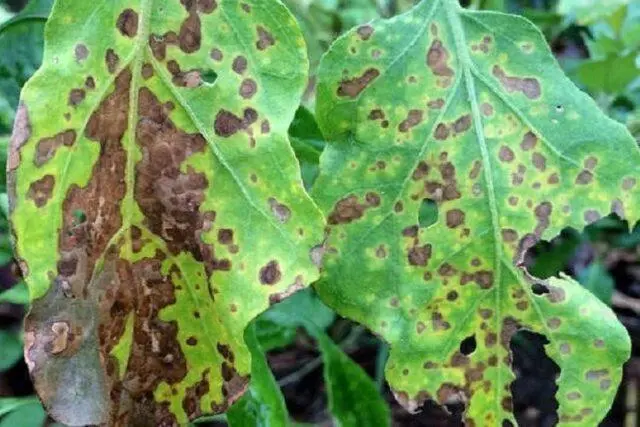
If the fight against the disease or pests is not started in time, all plantings may die.
What to do if the leaves of the eggplant dry in the greenhouse
In the case when the eggplant leaves turn yellow and dry, the first step is to understand what caused the problem. This sign is a symptom of the pathological process and disappears only when its cause is eliminated. The sooner this is done, the higher the chance of saving the crop.
Proper care
If the leaves began to dry due to improper care, then in addition to correcting it, eggplants should be helped to cope with stress. It is advisable to feed with yeast or boric acid. In the first case, 10 g of the product is diluted in 10 liters of water at room temperature, infused for two days, added to water in a ratio of 1:10, and sprayed. In the second case, 5 g of boron is dissolved in 10 ml of hot water, diluted with 10 liters of cold water, and the plantings are irrigated.
Treatment of diseases
In case of eggplant diseases, all leaves with affected areas are cut off and burned from the bushes. Further, plantings are treated with special preparations: for fusarium – Benazol, Fundazol, Consento, for verticillium wilt – Previkur, Vitaros, Topsin-M.
As a preventive measure for the above ailments, as well as tobacco mosaic, eggplants in the greenhouse are sprayed with whey or yeast.
Pest extermination
If pests attacked the plants, then with small clusters of them, the bushes are treated with infusion of onion peel, garlic, marigolds or soapy water. If such actions do not bring results, then biological agents or insecticides are used. Kraft, Kleschevit, Neoron, Aktara, Actellik help well from spider mites.
To scare away insects, preventive procedures are carried out. For this, many vegetable growers grow tansy, calendula, and marigolds in a greenhouse. They do not allow caterpillars, the Colorado potato beetle, ants and even a nematode to start up in the beds.
preventive measures
So that the eggplant leaves in the greenhouse do not begin to dry, it is recommended to take preventive measures. The main one is the organization of proper care: proper watering, maintaining humidity and temperature, timely fertilizer, pest and disease control. The culture quickly reacts to the mistakes of agricultural technology, its leaf plates begin to turn yellow, dry, wither and eventually fall off, the flowers become smaller, the ovaries do not form. You can save the harvest only by providing all the necessary conditions.
Measures that prevent the occurrence of problems are considered:
- Soil renewal. It is difficult to observe crop rotation in a greenhouse, therefore it is recommended to remove the top layer of soil in it every year and replace it with a new one. Be sure to cultivate the land before planting: loosen heavy soil with manure or sand, acidic lime, mix peat with compost or soddy soil.
- Soil loosening. At the onset of the growing season, the procedure not only helps air flow to the roots of eggplant, but also significantly reduces the risk of developing fungal diseases.
- Hardening off seedlings. So that young shoots do not begin to dry after planting, they are gradually accustomed to the conditions in the greenhouse before planting in the ground.
- Organization of proper hydration. At the beginning of the growing season, about three liters of water are consumed per bush once a week, with the onset of flowering 4-5 liters every three days. In this case, the moistening solution should be approximately the same temperature as the soil. The procedure is carried out in the evening, strictly under the bush, preventing water from getting on the leaves.
- Ventilation of the greenhouse. With the advent of hot days, the room becomes stuffy, which is why it is often ventilated. Sometimes, to reduce the temperature, containers with cold water are placed between the rows.
- Disease prevention. In the greenhouse, eggplants are more often exposed to diseases, therefore, before sowing, it is advisable to keep the material in a solution of manganese, and disinfect the soil. Experienced vegetable growers advise regularly spraying plants with folk remedies, or several times a season with fungicides such as Trichodermin or Antractol.
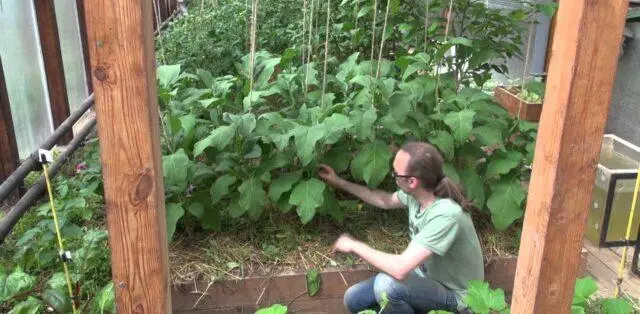
Eggplants in a greenhouse are best planted away from the entrance to it.
Conclusion
Eggplant leaves dry in a greenhouse – an alarming sign for every gardener. This can be a complex of reasons that should be quickly diagnosed and tried to correct. Leaves can dry out due to disease, unsuitable microclimate in the greenhouse, pathological processes. In addition, the natural reaction of eggplants to stress can be expressed in this way. If the gardener notices the problem in time and eliminates its cause, then the culture will quickly regain strength and be able to bring a good harvest.









